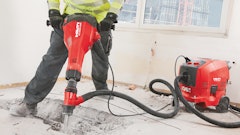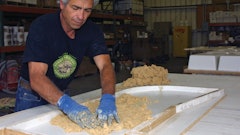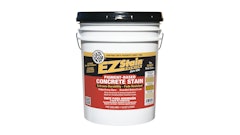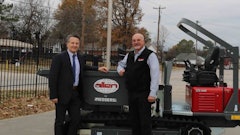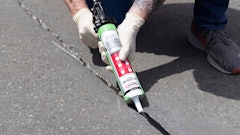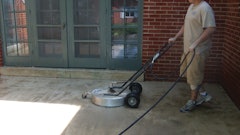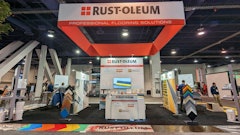
What happened?
The epoxy coating in this photo failed because of a poor bond between the concrete and the coating in an issue commonly known as hot tire pickup. This issue typically occurs in garages and on driveways where people park cars in the same spot time after time.
Tires heat up during use, causing tire degeneration. When the driver parks his or her car in a garage or on a driveway, paraffin from hot tires embeds in the cementitious material, creating a rubberized barrier, or bond breaker, over time. This paraffin buildup is more common with high performance tires, but it can happen with most tires. When a contractor applies an epoxy or other coating to a concrete slab with this paraffin buildup, the rubberized layer prevents the coating from properly bonding with the concrete, eventually resulting in the epoxy losing adhesion from the surface.
Whose fault was it?
In most cases, improper preparation of the concrete before coating application is the root cause of hot tire pickup.
Prevent this from happening to you
Concrete preparation is the key to preventing hot tire pickup. Typically, the paraffin penetrates into the surface of the concrete only 1⁄16 or 1⁄8 inch deep. Jeff Wells, H&C Decorative Concrete Products, suggests a contractor cleans, degreases and profiles the concrete to best prepare the surface before applying an epoxy or other coating.
First, clean and degrease the area that will receive the coating, concentrating on the tire lanes where the vehicle comes to rest. It is important to degrease the area before the abrasion step so as not to grind grease or residue into the concrete.
Water and degreaser won’t remove tire residue since water cannot break down the rubberized material, making mechanical abrasion necessary to both remove the paraffin buildup and create a profile on the surface of the concrete to give the coating a better surface to which it can mechanically bond. It is not necessary to mechanically abrade the entire surface of the concrete if car tires are parked in the same spot time after time. Wells suggests a phosphoric acid etch, 80-grit sand paper on a sanding pole or an 18-inch grinder to create a profile equal to 120-grit sandpaper in the tire lanes only.
A water absorption test will tell you when your surface is ready to receive a sealer. “A dime-sized bead of water should penetrate the surface of the concrete in 10 to 15 seconds. That’s when you know you have removed the tire residue and have an ideal substrate ready to be sealed,” Wells says. “If the water does not penetrate in 30 to 45 seconds, repeat the abrasion process until it does.”
Wells says this particular issue is not common on new construction because it is an issue that occurs with a history of parked cars on the concrete over time. However, on jobs where contractors parked their vehicles in the same areas day after day during construction, contractors applying coatings might encounter paraffin buildup. For this reason, it is always a good idea to check the surface of the concrete with a water absorption test to ensure there is nothing on the concrete that will prevent an epoxy or coating from properly bonding with the surface.






